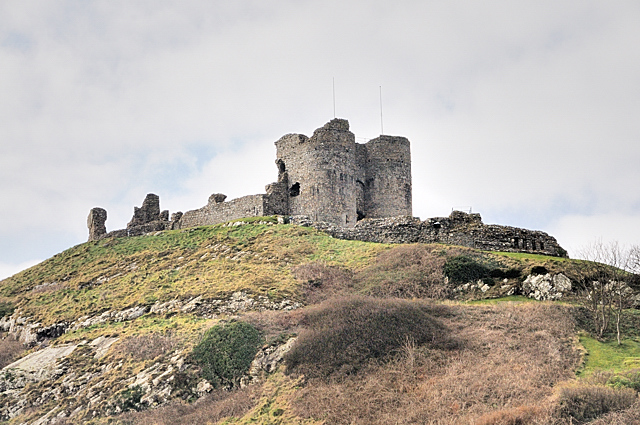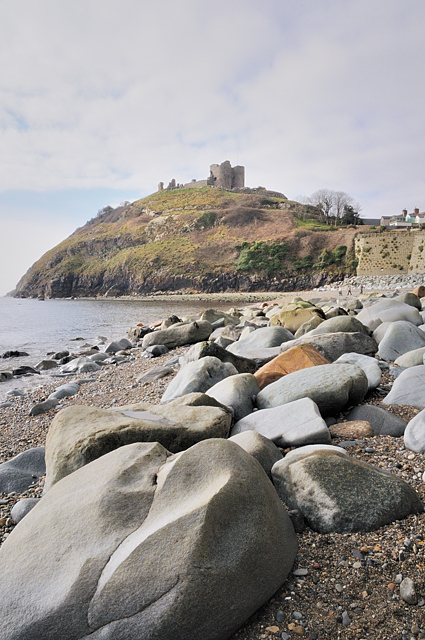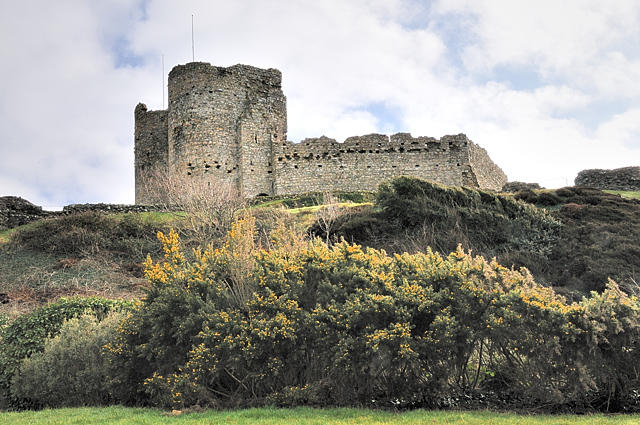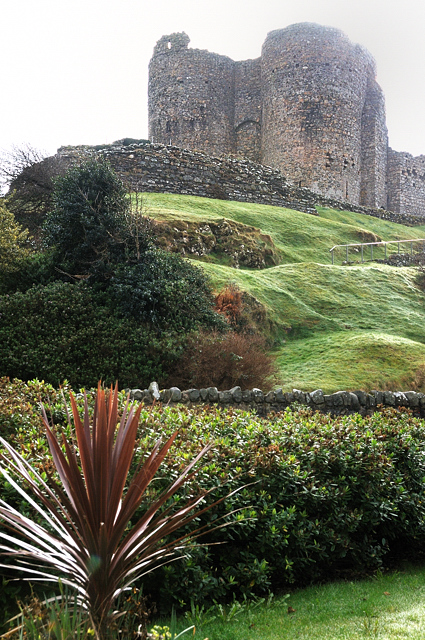Criccieth Castle
Criccieth, Caernarfonshire
|

Featured Location Guide |
This castle sits on the top of a headland
between two beaches overlooking the sea, Tremadog Bay, and it's most prominent
feature is the twin-towered gatehouse built by Prince Llywelyn ab Lorwerth.

|
History
Construction began in the early 13th Century by
Prince Llywelyn ab Lorwerth and later continued by his grandson Prince of Wales.
Today it's most prominent and an unusual feature for a Welsh Castle is its twin-towered
gatehouse which is believed to have been built between 1230 and 1240. It was a
focal point in the war between England Wales and eventually it was capture by
Edward I of England during his second campaign in 1283. His army rebuilt it,
including adding another tower to the wall of the inner ward and strengthening
the "Engine Tower" (now in ruins), which served as a foundation for a siege
engine. In the uprising against the English in 1294, along with Harlech
Castle and Aberystwyth Castle it was besiged by the Welsh. It was used as a
prison until 1404 when Owain Glyndŵr captured the castle, tearing down its walls
and setting it afire, some of its walls still show the scorch marks.
It has also been used by J.M.W Turner in a
series of paintings depicting shipwrecked mariners.
Today it is looked after by CADW and in the
visitor centre there is an exhibition with information about Welsh castles.
Today's Visitor Sees
Today the great gatehouse is the most
impressive part for its size and towering presence on the hilltop. As you
approach the village of Criccieth you can see it and it stays with you all the
way to parking the car.
 |
 |
For viewing you get to see the impressive
twin-towered gatehouse. Like other gatehouses, it was protected with arrowslits
and battlements, and the passage contained a portcullis and barred gate, and
murder holes which opened down on the passageway from above, ready to spew forth
liquids or missiles on some unsuspecting victim. Nothing much remains of the
interior rooms of the gate towers, except the shells of guardrooms on the lowest
level and large residential quarters on the two upper floors. The discovery of a
13th century crucifix inside one of the upper storey rooms has led to
speculation that a chapel may have filled one of the chambers.
The walls and towers of the castle are mostly
in ruins and from the top you get some stunning views of the surrounding
coastline and can see why it's strategic position was chosen, using the natural
defences of the sea but also allowing supplies to be brought in.

 A view from Castle Street
A view from Castle Street
It is also a spectacular castle to photograph
from the beach, the day we visited there was a sea mist, which kept changing
position and eventually it moved away completely allowing differing views of the
castle to be taken. It is certainly a dominant feature of this village, which
also has a small number of shops and eateries and plenty of B&B accommodation.
The beaches are a mixture of sand and pebbles and is vast. Opposite there is a
large green open space with picnic tables and a public toilet block which in
fact was shut when we visited at the end of February, but is probably open
during the busier summer months.

 A view from Castle Street
A view from Castle Street


.
Planning Grid
|
Location: |
Criccieth
Castle, Caernarfonshire |
|
Grid Reference: |
SH500377 |
|
Getting there: |
From A487 take the B4411 to Criccieth, over
the A497 towards the sea front, following the road onto the sea front where
you will come to the seafront car parking. |
|
Access: |
From car park, walk up hill to castle
entrance, then further up hill from visitor entrance to castle. |
|
Parking: |
On street parking both in the road outside the
castle entrance as well as down in the village on the sea front Pay &
Display 110yrds away. |
|
Facilities: |
Toilets, site exhibition and audio-visual
presentation |
|
Things To Do,
See and Photograph: |
Castle, beaches, boats, seascapes and clouds
if the right weather conditions. Quaint buildings. |
|
What to take: |
mixture of lenses, polarizer or grads |
|
Nature highlights: |
|
|
Address: |
Castle Street
Cricieth
Gwynedd |
|
Postcode: |
LL55 0DP |
|
Telephone: |
01766 522227 |
|
Opening times: |
Nov-Mar Fri & Sat 9.30am-4pm, Sun 11am-4pm.
Apr-Oct Daily 10am-5pm
Open site all other times - unstaffed with no
admission charge 10am-4pm |
|
Charges: |
Adult £3; Concession £2.60; Family £8.60
Welsh Residents Pass for the 60+ or 16 and
under living in Wales gives free access to all CADW sites.
See Here for Details.
English Heritage Members FREE (2 yrs +) 50%
first year of membership. |
|
Photo Restrictions: |
None |
|
Other Restrictions: |
|
|
Special Needs Access: |
Ramp into reception and exhibition area on
ground floor. Steps to exhibition and viewpoint can be avoided using a side
door - ask staff member for assistance. Steep path leads up to castle. |
|
Special Needs Facilities: |
RADAR key toilet on site. Dropping off point
by entrance. |
|
Children Facilities: |
None specific - although the beach of course
is a great playground |
|
Dogs Allowed: |
only assistance dogs around the castle site |
|

|
Please let us know any other information that we
can add to the Further information and Planning Grids or page and any errors that you discover. Before making a long trip to any location it is always
wise to double check the current information, websites like magazines may be
correct at the time the information is written, but things change and it is of
course impossible to double check all entries on a regular basis. If you have
any good photographs that you feel would improve the illustration of this page
then please let us have copies. In referring to this page it is helpful if you
quote both the Page Ref and Classification from the Grids above. To print the
planning grid select it then right click and print the selected area.
Please submit information on locations you discover so
that this system continues to grow.
|